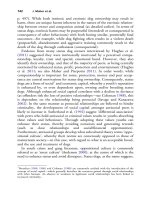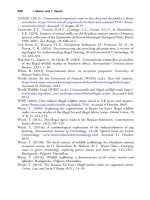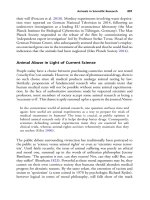The palgrave international handbook of a 140
Bạn đang xem bản rút gọn của tài liệu. Xem và tải ngay bản đầy đủ của tài liệu tại đây (37.37 KB, 1 trang )
Status Dogs
Jennifer Maher, Harriet Pierpoint and Claire Lawson
Introduction
Historically ‘status’ dogs have taken many forms: as fashion items (toy or
‘bag’ dogs), national icons (English bulldog) and status symbols (such as the
American pit bull terrier [pit bull] or Staffordshire bull terrier [sbt]). In
previous decades, reference to ‘status’, ‘accessory’ or ‘fashion’ dogs implied
association between some (usually) small dog breeds and rich and famous
persons (that is, the Queen’s corgi, Paris Hilton’s chihuahua). These breeds
then act as conduits for transferring the status and image of these iconic
owners to other dog owners (Hirschman 2002).1 The dog becomes inextricably linked to the owner’s identity. This relationship commonly requires
the dog to look and behave in a certain way, which often conflicts with their
1
As is commonly promoted in the purchase of other status items such as cars, clothes and food.
J. Maher (*) Á H. Pierpoint
Centre for Criminology, University of South Wales, Pontypridd,
United Kingdom
e-mail: ;
C. Lawson
Royal Society for the Prevention of Cruelty to Animals & Cardiff University,
Cardiff, United Kingdom
e-mail: LawsonCE@cardiff.ac.uk
© The Author(s) 2017
J. Maher et al. (eds.), The Palgrave International Handbook of Animal
Abuse Studies, DOI 10.1057/978-1-137-43183-7_7
131









